
Frankenstein's Daughter is an independently made 1958 American black-and-white science fiction/horror film drama, produced by Marc Frederic and George Fowley, directed by Richard E. Cunha, that stars John Ashley, Sandra Knight, Donald Murphy, and Sally Todd. The film was distributed by Astor Pictures and was released theatrically as a double feature with Missile to the Moon.

Dracula is a 1958 British gothic horror film directed by Terence Fisher and written by Jimmy Sangster based on Bram Stoker's 1897 novel of the same name. The first in the series of Hammer Horror films starring Christopher Lee as Count Dracula, the film also features Peter Cushing as Doctor Van Helsing, along with Michael Gough, Melissa Stribling, Carol Marsh, and John Van Eyssen. In the United States, the film was retitled Horror of Dracula to avoid confusion with the U.S. original by Universal Pictures, 1931's Dracula.

The Entity is a 1982 American supernatural horror film directed by Sidney J. Furie, and written by Frank De Felitta, who adapted his 1978 novel of the same name. The film stars Barbara Hershey as a single mother in Los Angeles who is raped and tormented by an invisible assailant.
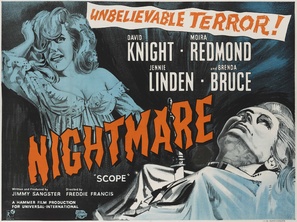
Nightmare is a 1964 British horror film directed by Freddie Francis and starring Jennie Linden. It was written by Jimmy Sangster, who also produced the film for Hammer Films. The film focuses on a young girl in a finishing school who is plagued by nightmares concerning her institutionalized mother.

Blood of the Vampire is a 1958 British colour horror film directed by Henry Cass and starring Donald Wolfit, Barbara Shelley, and Vincent Ball. The film was produced by Robert S. Baker and Monty Berman for Tempean Films, from a screenplay by Jimmy Sangster.
Sidney Joseph Furie is a Canadian film director, screenwriter, and producer best known for his extensive work in both British and American cinema between the 1960s and early 1980s. Like his contemporaries Norman Jewison and Ted Kotcheff, he was one of the earliest Canadian directors to achieve mainstream critical and financial success outside their native country at a time when its film industry was virtually nonexistent. He won a BAFTA Film Award and was nominated for a Palme d'Or for his work on the acclaimed spy thriller The Ipcress File (1965) starring Michael Caine.

The Leech Woman is a 1960 black-and-white American horror film directed by Edward Dein, produced by Joseph Gershenon, and starring Coleen Gray, Grant Williams, Gloria Talbott and Phillip Terry. The plot follows a middle-aged American woman, desperate to be young again, who uses an ancient, secret African potion to regain her lost youth and beauty. The potion works, but only temporarily, requiring repeated usage.
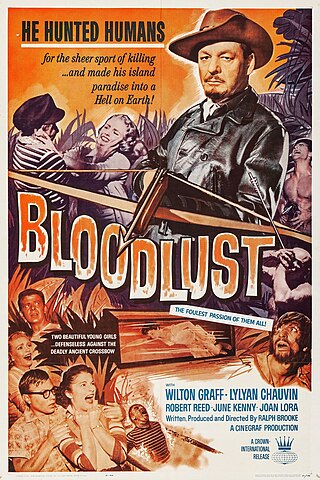
Bloodlust! is a 1961 American horror thriller film written, directed and produced by Ralph Brooke and starring Wilton Graff, June Kenney, Joan Lora, Eugene Persson, and Robert Reed. It is based on Richard Connell's 1924 short story "The Most Dangerous Game." It was produced by Robert H. Bagley. Its plot follows four young adults who visit a tropical island only to become prey for a sadistic hunter. It was filmed in 1959 but not released until 1961, when it was the second film on a double feature with The Devil's Hand.

Curse of the Faceless Man is a 1958 independently made American low-budget black-and-white horror film, produced by Robert E. Kent, directed by Edward L. Cahn, that stars Richard Anderson, Elaine Edwards, Adele Mara, and Luis van Rooten. Science fiction writer Jerome Bixby wrote the screenplay. The film was theatrically released in the U.S. by United Artists as a double feature with It! The Terror from Beyond Space.
The Dead One is a 1961 American independent horror film written, produced and directed by Barry Mahon. It stars John McKay, Linda Ormond, Monica Davis and Clyde Kelly. The narrative follows two cousins—one a businessman (McKay), the other a woman who practices voodoo (Davis)—who each seek control of their family's Louisiana plantation.

Cult of the Cobra is a 1955 American black-and-white horror film from Universal-International Pictures, produced by Howard Pine, directed by Francis D. Lyon, that stars Faith Domergue, Richard Long, Kathleen Hughes, Marshall Thompson, Jack Kelly, William Reynolds, and David Janssen. The film was released as a double feature with Revenge of the Creature.

The Haunting of Molly Hartley is a 2008 American supernatural horror film written by John Travis and Rebecca Sonnenshine and directed by Mickey Liddell. The film, starring Haley Bennett, Chace Crawford, AnnaLynne McCord, and Jake Weber, was panned by critics but was a mild commercial success, grossing $15.4 million against a $5 million budget.

Doctor Blood's Coffin is a 1961 British horror film produced by George Fowler, and directed by Sidney J. Furie. It stars Kieron Moore, Hazel Court, and Ian Hunter. The story is that of young biochemist Dr Peter Blood, who returns to his hometown in Cornwall with the belief that he can selectively restore life by transplanting the living hearts of 'undeserving' people into dead people who 'deserve' to live. The film is significant for being one of the first two zombie films to be shot in colour, the other being the obscure 1961 American film The Dead One, and for its early portrayal of zombies as homicidal rotting cadavers. The movie was released in the UK in January 1961 and in the US in April of that year, where it was on a double bill with another British film, The Snake Woman (1961).
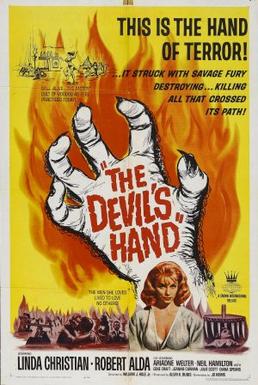
The Devil's Hand is a 1961 American independent horror film. It was produced by Alvin K. Bublis and directed by William J. Hole Jr. The film stars Linda Christian, Robert Alda, Ariadna Welter and Neil Hamilton. The movie was made in 1959 by Rex Carlton Productions, but not distributed until 1961 by Crown International Pictures. It follows the activities of a group of modern-day Los Angelenos who are members of a cult that worships Gamba, the Great Devil God.
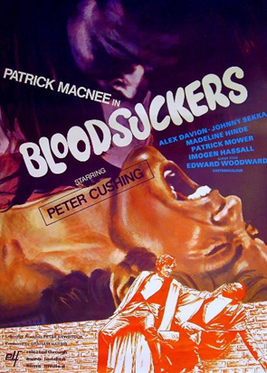
Incense for the Damned is a 1971 British horror film directed by Robert Hartford-Davis and starring Patrick Macnee, Johnny Sekka, Madeleine Hinde, Alexander Davion, Peter Cushing and Edward Woodward. It is based on the 1960 Simon Raven novel Doctors Wear Scarlet. The film centres on Richard Fountain, a scholar of Greek mythology at the University of Oxford, who has fallen under the influence of Chriseis, a mysterious Greek woman who is a modern-day vampire.

The Frozen Dead is a 1966 British science fiction horror film written, produced and directed by Herbert J. Leder and starring Dana Andrews, Anna Palk and Philip Gilbert.
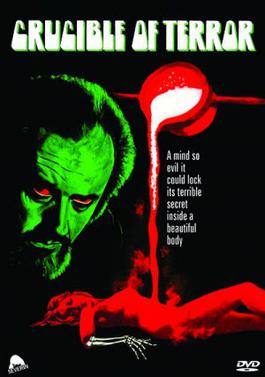
Crucible of Terror is a 1971 British horror film and directed by Ted Hooker and starring Mike Raven, Mary Maude and James Bolam. Its plot centres on a reclusive artist in Cornwall. Besides painting young women, he has encased the living body of one in plaster and poured into it, through an eyehole, molten bronze, which killed her, made a cast of her body and turned it into a beautiful sculpture. After the bronze sells at a good price, he finds a 'suitable' second woman and attempts to do the same. But before he can, he meets a grisly demise at the hands of the first woman, a member of a 'weird sect', whose spirit has possessed the body of the second woman.

Terror is a 1978 British supernatural horror slasher film written by David McGillivray and directed by Norman J. Warren. It stars John Nolan and Carolyn Courage as two cousins who fall victim to a curse that a witch placed on their ancestors.

The Woman Eater is a low budget 1958 British horror film directed by Charles Saunders and starring George Coulouris and Vera Day. Produced by Guido Coen, the film recounts the story of a crazed scientist who feeds women to a flesh-eating tree in return for a serum that can bring the dead back to life. The film was released in the UK in 1958 by Eros Films on a double bill with the Swedish crime drama Blonde in Bondage (1957).
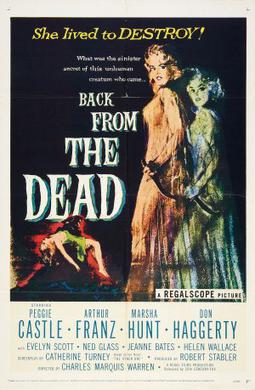
Back from the Dead is a black and white 1957 American horror film produced by Robert Stabler and directed by Charles Marquis Warren for Regal Films. The film stars Peggie Castle, Arthur Franz, Marsha Hunt and Don Haggerty. The narrative concerns a young woman who, under the influence of a devil cult, is possessed by the spirit of her husband's first wife, who had died six years earlier. The screenplay was written by Catherine Turney from her novel The Other One. The film was released theatrically on August 12, 1957, by 20th Century Fox on a double bill with The Unknown Terror.


















